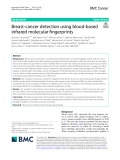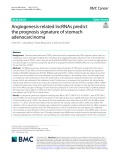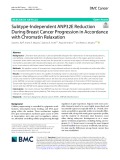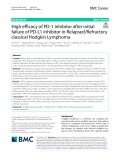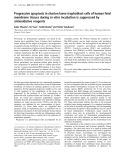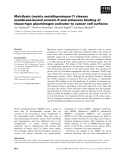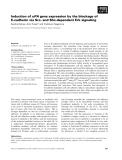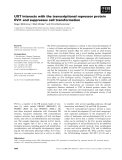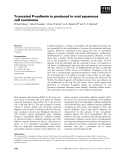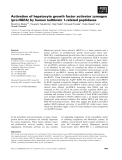
Tumor progression
-
Ovarian cancer constitutes one of the most lethal gynecologic malignancies for females. Currently, early detection strategies and therapeutic options for ovarian cancer are far from satisfactory, leading to high diagnosis rates at late stages and disease relapses. New avenues of therapy are needed that target key processes in ovarian cancer progression.
 20p
20p  vimichaelfaraday
vimichaelfaraday
 25-03-2022
25-03-2022
 16
16
 1
1
 Download
Download
-
Breast cancer screening is currently predominantly based on mammography, tainted with the occurrence of both false positivity and false negativity, urging for innovative strategies, as effective detection of early-stage breast cancer bears the potential to reduce mortality.
 9p
9p  vielonmusk
vielonmusk
 21-01-2022
21-01-2022
 37
37
 1
1
 Download
Download
-
Colorectal cancer is a malignant gastrointestinal cancer, in which some advanced patients would develop cancer cachexia (CAC). CAC is defined as a multi-factorial syndrome characterized by weight loss and muscle loss (with or without fat mass), leading to progressive dysfunction, thereby increasing morbidity and mortality
 15p
15p  vielonmusk
vielonmusk
 21-01-2022
21-01-2022
 9
9
 1
1
 Download
Download
-
Stomach adenocarcinoma (STAD), which accounts for approximately 95% of gastric cancer types, is a malignancy cancer with high morbidity and mortality. Tumor angiogenesis plays important roles in the progression and pathogenesis of STAD, in which long noncoding RNAs (lncRNAs) have been verified to be crucial for angiogenesis.
 14p
14p  vielonmusk
vielonmusk
 21-01-2022
21-01-2022
 10
10
 0
0
 Download
Download
-
Chromatin state provides a clear decipherable blueprint for maintenance of transcriptional patterns, exemplifying a mitotically stable form of cellular programming in dividing cells. In this regard, genomic studies of chromatin states within cancerous tissues have the potential to uncover novel aspects of tumor biology and unique mechanisms associated with disease phenotypes and outcomes.
 15p
15p  vielonmusk
vielonmusk
 21-01-2022
21-01-2022
 14
14
 1
1
 Download
Download
-
We sought to understand the clinical course and molecular phenotype of patients who showed disease progression after programmed cell death ligand 1 (PD-L1) inhibitor treatment but subsequently responded to PD-1 inhibitor treatment. We also explored the response to PD-1-axis targeted therapy of classical Hodgkin lymphoma (cHL) according to genetically driven PD-L1 and programmed cell death ligand 2 (PD-L2) expression.
 8p
8p  vielonmusk
vielonmusk
 21-01-2022
21-01-2022
 15
15
 1
1
 Download
Download
-
Cancer cells prefer utilizing aerobic glycolysis in order to exacerbate tumor mass and maintain un-regulated proliferative rates. As a key glycolytic activator, phosphofructo-2-kinase/fructose-2,6-bisphosphatase 3 (PFKFB3) has been implicated in multiple tumor type progression.
 11p
11p  vielonmusk
vielonmusk
 21-01-2022
21-01-2022
 12
12
 1
1
 Download
Download
-
Objectives: Evaluation of technical success as complete ablation rate, tumor progression, the safety and short-term outcome of radiofrequency ablation (RFA) in hepatocellular carcinoma (HCC). Subjects and methods: 30 patients with HCC were treated with radiofrequency ablation from Jun 1, 2014 to Jun 1, 2017 at Binhdan Hospital.
 5p
5p  cumeo2008
cumeo2008
 30-07-2018
30-07-2018
 29
29
 2
2
 Download
Download
-
Amplification of N-myc oncogene is a frequent event in advanced stages of human neuroblastoma and correlates with poor prognosis and enhanced neovascularization. Angiogenesis is an indispensable prerequisite for the progression and metastasis of solid malignancies, which is modulated by tumor suppressors and oncogenes. We have addressed the possibility that N-myc oncogene might regulate angiogenesis in neuroblastoma. Here, we report that experimental N-Myc overexpression results in down-regulation of leukemia inhibitory factor (LIF), a modulator of endothelial cell proliferation....
 10p
10p  system191
system191
 01-06-2013
01-06-2013
 34
34
 4
4
 Download
Download
-
Previously, we demonstrated apoptotic cell death in the chorion laeve trophoblast layer of human fetal membrane tissues during the late stages of pregnancy, the progression of apoptosis during incubation in vitro, and its suppression by a low concentration of glucocorticoid hormones.
 8p
8p  system191
system191
 01-06-2013
01-06-2013
 33
33
 5
5
 Download
Download
-
In this review, we summarize recent progress in studying three main classes of prenyltransferases: (a) isoprenyl pyrophosphate synthases (IPPSs), which catalyze chain elongation of allylic pyrophosphate substrates via consecutive condensation reactions with isopentenyl pyrophosphate (IPP) to generate linear polymers with defined chain lengths; (b) protein prenyltransferases, which catalyze the transfer of an isoprenyl pyrophosphate (e.g. farnesyl pyrophosphate) to a protein or a peptide; (c) prenyltransferases, which catalyze the cyclization of isoprenyl pyrophosphates.
 16p
16p  research12
research12
 01-06-2013
01-06-2013
 49
49
 4
4
 Download
Download
-
Matrilysin (matrix metalloproteinase-7) plays important roles in tumor progression. It was previously found that matrilysin binds to the surface of colon cancer cells to promote their metastatic potential. In this study, we identified annexin II as a novel membrane-bound substrate of matrilysin. Treatment of human colon cancer cell lines with active matrilysin released a 35 kDa annexin II form, which lacked its N-terminal region, into the culture supernatant. The release of the 35 kDa annexin II by matrilysin was significantly enhanced in the presence of serotonin or heparin....
 14p
14p  research12
research12
 29-04-2013
29-04-2013
 39
39
 2
2
 Download
Download
-
In recent years major progress has been made in elucidating the mechanism and structure of catalytic RNA molecules, and we are now beginning to understand ribozymes well enough to turn them into useful tools. Work in our laboratory has focused on the development of twin ribozymes for site-specific RNA sequence alteration. To this end, we followed a strategy that relies on the combination of two ribozyme units into one molecule (hence dubbed twin ribozyme).
 11p
11p  fptmusic
fptmusic
 11-04-2013
11-04-2013
 40
40
 2
2
 Download
Download
-
The contributions of human DNA polymerases (pols)a, dande during S-phase progression were studied in order to elaborate how these enzymes co-ordinate their functions during nuclear DNA replication. Pol d was three to four times more intensely UV cross-linked to nascent DNA in late compared with early S phase, whereas the cross-linking of pols aande remained nearly constant throughout the S phase.
 18p
18p  inspiron33
inspiron33
 25-03-2013
25-03-2013
 66
66
 4
4
 Download
Download
-
Loss of E-cadherin-mediated cell–cell adhesion and expression of proteolytic enzymes characterize the transition from benign lesions to invasive, metastatic tumor, a rate-limiting step in the progression from adenoma to carcinoma in vivo. A soluble E-cadherin fragment found recently in the serum and urine of cancer patients has been shown to disrupt cell–cell adhe-sion and to drive cell invasion in a dominant-interfering manner.
 14p
14p  inspiron33
inspiron33
 23-03-2013
23-03-2013
 41
41
 3
3
 Download
Download
-
The EVI1 transcriptional repressor is critical to the normal development of a variety of tissues and participates in the progression of acute myeloid leu-kaemias. The repressor domain (Rp) was used to screen an adult human kidney yeast two-hybrid library and a novel binding partner designated ubiquitously expressed transcript (UXT) was isolated.
 12p
12p  galaxyss3
galaxyss3
 21-03-2013
21-03-2013
 40
40
 5
5
 Download
Download
-
Cadherins belong to a family of homophilic cell–cell adhesion proteins that are responsible for the establishment of a precise cell architecture and tissue integrity. Moreover, experimental data suggest that loss of intercellular adhesion is inversely correlated with cellular differentiation. Furthermore, dedifferentiation is closely linked to tumor progression.
 13p
13p  galaxyss3
galaxyss3
 07-03-2013
07-03-2013
 35
35
 2
2
 Download
Download
-
Hepatocyte growth factor activator (HGFA) is a serine protease and a potent activator of prohepatocyte growth factor⁄scatter factor (pro-HGF⁄SF), a multifunctional growth factor that is critically involved in tis-sue morphogenesis, regeneration, and tumor progression.
 15p
15p  media19
media19
 06-03-2013
06-03-2013
 30
30
 3
3
 Download
Download
-
Breast cancer cells exhibit excessive proteolysis, which is responsible for extensive extracellular matrix degradation, invasion and metastasis. Besides other proteases, lysosomal cysteine protease cathepsin B has been impli-cated in these processes and the impairment of its intracellular activity was suggested to reduce harmful proteolysis and hence diminish progression of breast tumors.
 12p
12p  media19
media19
 04-03-2013
04-03-2013
 50
50
 2
2
 Download
Download
-
Overexpression of the ErbB2 receptor is associated with the progression of breast cancer, and is a sign of a poor prognosis. Herceptin, a humanized antibody directed to the ErbB2 receptor, has been proven to be effective in the immunotherapy of breast cancer. However, it can result in cardiotoxicity, and a large fraction of breast cancer patients are resistant to Herceptin treat-ment.
 13p
13p  vinaphone15
vinaphone15
 28-02-2013
28-02-2013
 43
43
 3
3
 Download
Download
CHỦ ĐỀ BẠN MUỐN TÌM









